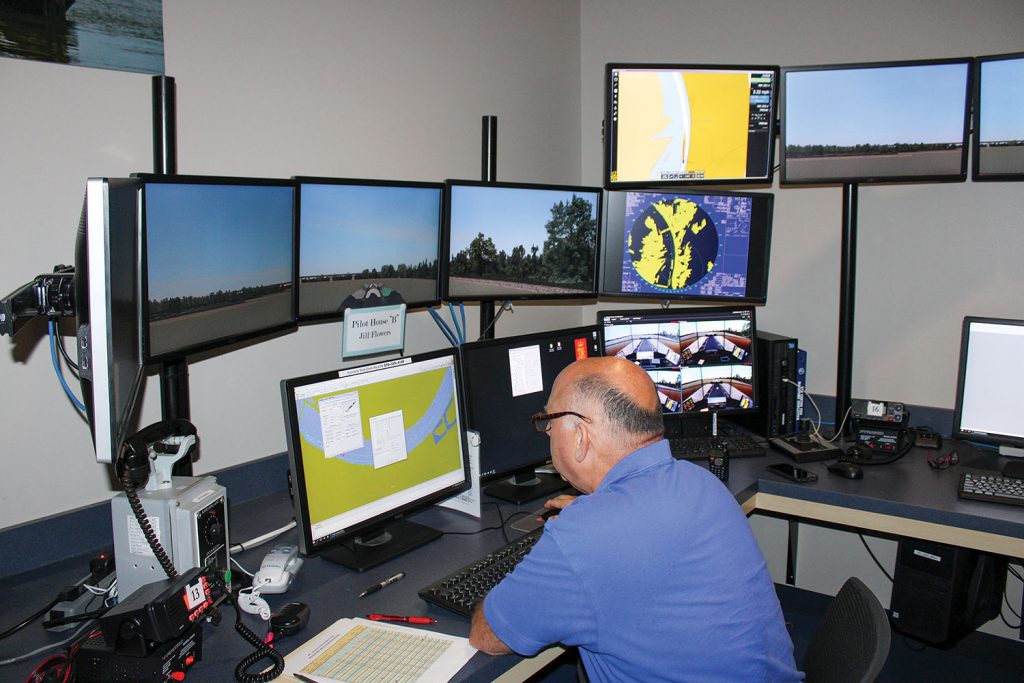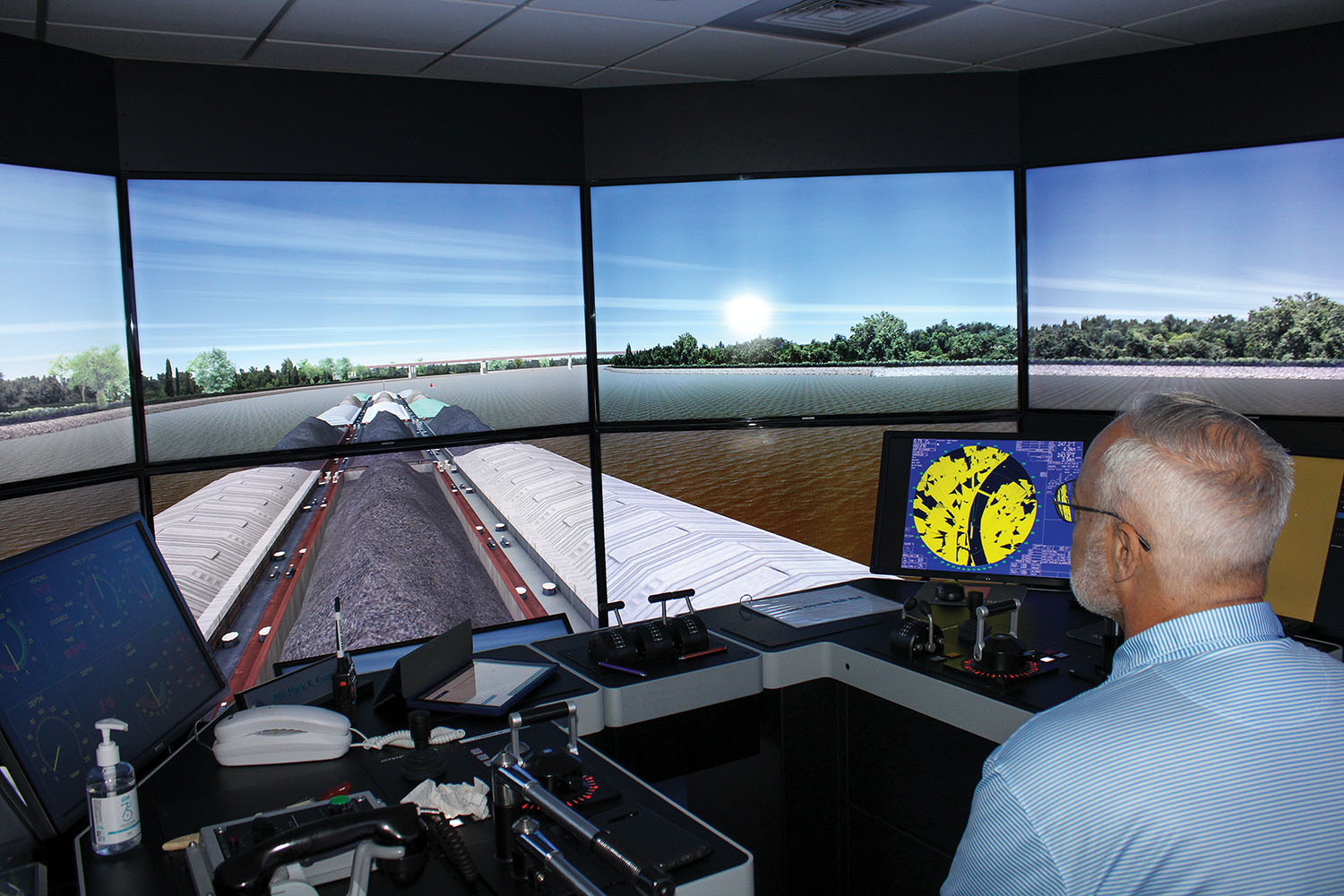Capt. Mike Coley looked up from where he was piloting a tow beneath a simulated new Interstate 49 bridge across the Arkansas River.
“This is one of the times when they ask us our input, and you can give it over several days,” he said before reaching for a tablet computer.
Coley, a Canal Barge Company captain, used the tablet to answer questions in an online survey regarding bridge pier placement, then waited for the next of 80 possible scenarios in the navigational feasibility study the Seamen’s Church Institute (SCI) is conducting for bridge design engineer HNTB Corporation and bridge owner Arkansas Department of Transportation (ARDOT).
The study, conducted October 11–15 at SCI’s Center for Maritime Education in Paducah, Ky., is designed to help determine optimal pier placement, taking into account both safety for those piloting beneath the bridge and economy for the taxpayers funding the construction.
Scenarios included tows upbound and downbound, loaded and empty, during the day and at night and under various water flow conditions, said John Arenstam, assistant director for SCI’s Center for Maritime Education in Paducah.
Computerized record-keeping logged how close pilots came to any obstructions. That information, combined with the feedback from the pilots, will help determine the next steps in bridge construction, said Stephen Polk, SCI’s director for maritime education.
“We just want to make sure it’s safe and not an unreasonable impediment to navigation,” Polk said of the feasibility study.
HNTB reached out to SCI in March regarding the study. Matt Hyner, SCI’s database manager, performed a site survey in July. Then, in September, SCI performed external testing and validation in Paducah with HNTB representatives and pilots from Kirby, American Commercial Barge Line and Canal Barge Company.

The feasibility study this month allowed multiple pilots to have a voice in the navigational implications for the proposed bridge.
Coley said that was what appealed to him, as he hopes to have an impact in helping engineers to choose a bridge design that works just as well for those passing on towboats underneath it as it does for the cars and trucks on it.
“I certainly do hope this will help the next generation of pilots coming up and that they will do the same for the ones coming after them,” he said.
The simulations are designed to streamline the design and construction process and satisfy both the Coast Guard and maritime industry representatives on the impact of the bridge on navigation. Ultimately, the purpose of SCI’s role in the feasibility study is to aid in the regulatory permitting process and to ensure the proposed bridge doesn’t impede the navigation channel. Feasibility studies like this also are meant to demonstrate to stakeholders that projects will function as designed.
Through the integration of tablet computers and online pilot assessments, feedback is gathered immediately, in real time, and pier placements, bridge alignments or other factors can be adjusted on-site with pilots testing them immediately.
Last year, SCI performed five feasibility studies, and this year it will conduct four studies.
Polk said the feasibility studies are just one part of SCI’s continuing commitment to mariner safety. The feasibility study process SCI uses for bridge designs can also be used for new docks, terminal expansions, waterway deepening and widening projects and evaluating dredge profiles, as well as to assist in vessel design, Polk said. Companies can even use simulation data to write policies and procedures, such as determining maximum operating parameters and in which circumstances assist boats may be needed.
“When you have a $500 million dock, you don’t want any surprises,” he said.
Previous feasibility studies have included those for terminals and docks in the Port of Corpus Christi to service Very Large Crude Carriers (VLCCs) and one connected to a proposed large-scale sediment diversion project south of New Orleans on the Mississippi River. Earlier this month, the Houston center held training for representatives from the National Transportation Safety Board and the Coast Guard, thanks to Blessey Marine Services, which provided six student seats in the simulator class.
For the Arkansas River bridge study, the simulations were livestreamed online so that stakeholders unable to travel to Paducah could tune in and offer their feedback.
Training Evolution
Although SCI’s history of providing relief and support for mariners dates back to 1834, Polk said the nonprofit is increasingly turning to the latest technologies to carry out its missions, which include increasing mariners’ safety through education and training.
Methods and techniques continue to evolve.
“It used to be all classroom-based with books and traditional lectures,” Polk said.
By the end of the year, SCI will launch new e-learning modules for simulator classes, which will enable companies to have employees take blended learning modules before arriving for a simulator class. This preparation will ensure that students arriving to SCI’s training facilities are ready to simulate right away. The online work will help those conducting the simulator training to know a pilot’s knowledge level so they can focus on areas of need as well as assessing how well they understand and apply the material.
“It helps the student prepare but also helps us understand where they’re at,” Polk said.
SCI is launching 24 online classes on various subjects as part of the new e-learning option for customers who take advantage of the organization’s simulator programs.
Ultimately, because they won’t have to spend as much time in the classroom upon arrival, pilots can conduct more simulator runs and have more time to interact with trainers and ask questions, Polk said. Companies will also be able to track the data to better help those attending training improve their abilities over time.
Caption for top photo: Capt. Mike Coley of Canal Barge Company pilots a tow toward a simulated new Interstate 49 bridge across the Arkansas River. (Photo by Shelley Byrne)




